Every boot has its stiletto. When it comes to Italy, that stiletto is the region of Apulia along the Ionic and the Adriatic Sea. The country’s easternmost part – the coast near Otranto is only 80 km from Albania – and Italy’s flattest region with 98.5% of plain and hilly territory is waiting for you here. Due to its, by way of comparison, exposed position in the southeast, Apulia lagged slightly behind the remaining country’s development during early history in turn resulting in fascinating evidence of cultures long gone, some of which were even hardly represented in the rest of Italy. The top 10 sights of Apulia show you the most beautiful aspects of the boot’s stiletto.
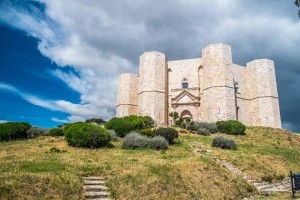
©Bigstock.com/Sabino Parente
Castel del Monte
A castle on top of the hill amidst Andria’s barren scenery has been posing a riddle to scientists for decades. Castel del Monte was built in the first half of the 13th century yet remained unfinished. The octagonal building with eight equally octagonal towers mainly consists of limestone and presumably served to show off the might of then-reigning Emperor Frederick II Hohenstaufen. You constantly come across the number eight throughout the entire castle, which was declared a UNESCO World Heritage Site in 1996 and has been appearing on the back of the Italian 1-cent coin since 2001. Numerous labyrinthine corridors and the curious, unadorned interior amaze and irritate equally. Can you solve this riddle?
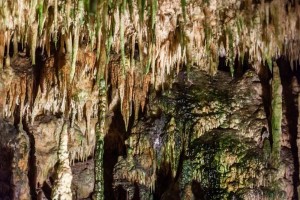
©Bigstock.com/Dario Lo Presti
Grotte di Castellana
In the early 20th century a hole in the earth served as a landfill for the population of Castellana Grotte. A very special cave was eventually discovered in this “hole” in 1938. The Grotte di Castellana with its impressive, brittle karst stone and fascinating calcareous deposits now ranks among Italy’s most beautiful caves attracting guests from all across the globe. During your hike you’ll also see fossils, wide gorges and strange rock formations, some of which shine in bright colours.
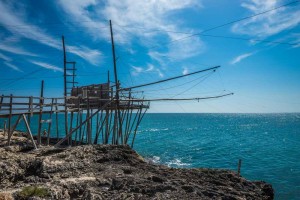
©Bigstock.com/javarman
Gargano
Italy’s spur also harbours the country’s largest national park. Gargano combines impressively lush and glorious flora and fauna with spiritual places. Take the pilgrimage church Santa Maria delle Grazie in San Giovanni Rotondo, which attracts pilgrims from all across the world. UNESCO World Heritage Site Sanctuary of Monte Sant’Angelo impresses and moves to this day. Among the speciose afforestation of the large national park are the last 100 Gargano roebucks in the world. Spiritual rest or natural enjoyment, Gargano is one of Apulia’s most beautiful places.
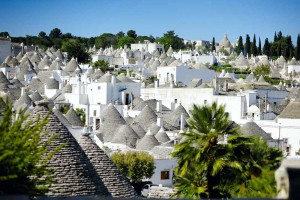
©Bigstock.com/tanialerro
The Trulli of Alberobello
The entire town of Alborello in Apulia was declared UNESCO World Heritage Site. It received this honour for the trulli, the conical buildings known far beyond regional boarders. The cone shape was originally used for shepherd’s huts, but Alberobello has entirely conical districts. Their construction dates back to Count Giangirolamo II Acquaviva of Conversano, who managed to bypass the ban of founding new settlements established by the Kingdom of Naples by using trulli constructions that could be disassembled quickly and with ease. Be enchanted by the view of the town’s many cones!
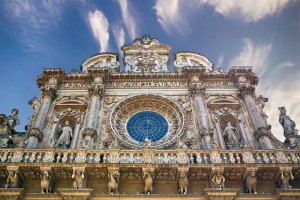
©Bigstock.com/dmitry kushch
Basilica di Santa Croce in Lecce
There was a time when it seemed like Basilica di Santa Croce would never be finished. Patron Gualtiero VI di Brenne died in 1353, only three years after constructions had begun. They were only picked back in 1549, but it would take another 150 years until completion. However, the basilica in Lecce now shines particularly brightly. The ostentatious baroque face with its Corinthian pillars and numerous ornaments wows. Caryatids, angel figurines and various statues carry the face and the aisles. Seventeen altars, countless frescoes and paintings line the equally beautiful and moving interior that absolutely must be experienced.
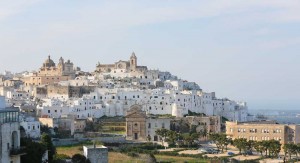
©Bigstock.com/Jorisvo
Ostuni
“The white town” in southeast Apulia already welcomes you from afar with its bright glow. Ostuni carries this moniker due to numerous whitewashed house in its historic town centre. It had already been the colour of choice in medieval times, partly because it lit up the narrow alleys, partly because it supposedly protected from the spreading of the plague. To this day all house owners are compelled to retain the uniform white townscape. When visiting Ostuni you should also stop by the breath-takingly beautiful baroque church Santa Maria Maddalena or the town hall with the baroque Oronzo pillar.
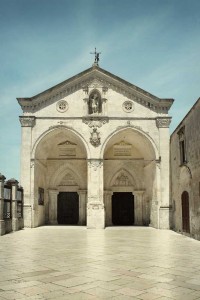
©Bigstock.com/ValentinaPhotos
Sanctuary of Monte Sant’Angelo
You’ll come across Western Europe’s oldest shrine dedicated to archangel Michael in the wide Gargano national park. Legend has it that the archangel appeared on the mountain in Monte Sant’Angelo on 8 May 492 AD. The sanctuary is located partly underground. Enter this Langobardic marvel, which has since been declared UNESCO World Heritage Site, through a portal promising the forgiveness of all sins. Inside the mountain, behind one of Apulia’s oldest bronze gates, a fascinating place of inner peace and contemplation is waiting for you.
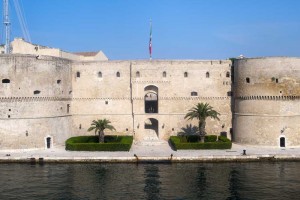
©Bigstock.com/Claudiogiovanni
Aragon Castle in Tarento
A small channel separates Isola del Borgo Antico from Tarento’s mainland. The foundations for a castle that once served to defend against attacks by the Republic of Venice and the Saracens before being eventually extended and turned into Aragon Castle in the late 15th century were laid here over 1,000 years ago. Continuous extension and expansion work led to today’s appearance with numerous towers, many corners and the amazing garden with a labyrinth. A small navy museum is waiting for you on the inside.
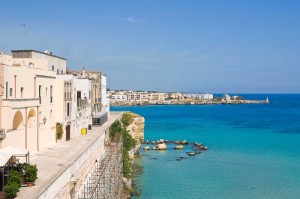
©Bigstock.com/Mi.Ti.
Otranto’s Borgo Antico
Otranto’s historic town centre is constantly in the run when talking about potential new destinations for World Heritage Sites. One of Italy’s most beautiful towns, which had already been populated during Middle Bronze Age, is home to numerous fascinating sights. Cathedral Santa Annunziata features an abundance of grand floor mosaics and an equally impressive crypt. Castello Aragonese, the Byzantine church San Pietro and the monumental tomb Torre Pinta, which is located on the outskirts, should also be part of your itinerary.
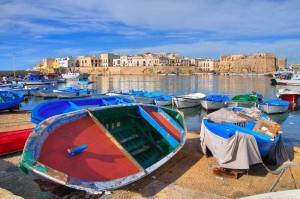
©Bigstock.com/Mi.Ti.
Gallipoli´s historic town centre
Gallipoli’s historic town centre is located on a rock island outside the mainland in the southernmost part of the boot’s stiletto. It is site of Apulia’s typical everyday life. The smell of fine delicacies wafts through the narrow alleys, the fish market offers freshly caught goods and serves as an ideal starting point for a tour around the island. Small souvenir shops, charming churches and the imposing castle accompany you on your way through this delightfully primal area that managed to retain its old charm.
Nature worth seeing, impressive architecture and an air of rustic, classic charm – all of that and much more makes Apulia special. Be enchanted by its fascinating history and the friendly people, and explore many other holiday options in Italy with the travel suggestions provided by ZAINOO!